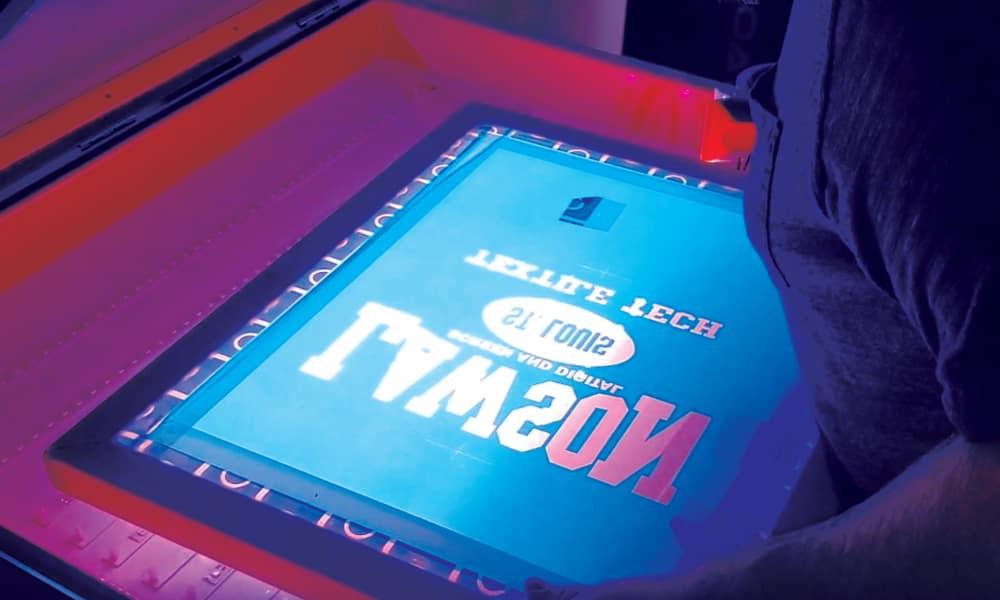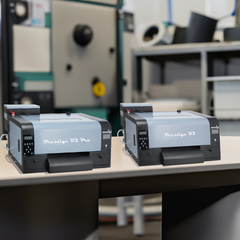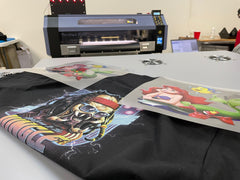Pinholes have a limited number of causes which any shop can eliminate. A minute or two of extra care can ensure a consistent, pinhole-free stencil.
1. If you use diazo direct emulsion be sure the diazo powder is completely dissolved before adding it to the emulsion. Check the sensitizer bottle's white cap liner for undissolved diazo particles. If you see them, recap the sensitizer bottle and shake it again.
2. Avoid air bubbles in sensitized emulsion. The necessary, vigorous shaking of the diazo bottle creates a head of foam which, if blended into the emulsion, is dispersed as air bubbles. Allow the dissolved diazo to stand about 15 minutes before adding it to the emulsion. But if, like most shops, yours is in a hurry, try this: after shaking the diazo, uncap the sensitizer bottle. Drape a small square of fine (280-330) mesh over the mouth of the bottle and secure it with a rubber band. Tilt the bottle just beyond the horizontal (so that the solution doesn't become "air bound") and pour it into the emulsion.
Air bubbles can also be introduced into the emulsion by the stirring-in of the diazo solution. After mixing the sensitizer solution into the emulsion, close the container and let it stand for a minimum of one hour until all air bubbles have dispersed.
Always stir until the color of the emulsion is uniform; this is the best way to insure thorough mixing. (Don't forget to scrape your stirrer across the sides and bottom of the emulsion container, so that all the emulsion is mixed with the diazo sensitizer.) And don't forget to use a clean stirrer!
3. Poor screen preparation is a major cause of pinholes. Particles of dirt, wood frame chips, and dust remaining on the fabric during coating will be trapped in the emulsion. Opaque, they will block light from hardening the emulsion beneath them, so that the emulsion in these small areas will wash away after exposure. The result -- pinholes. Even if the light scatters around them, hardening them within the emulsion, they will act as "irritants" under the flexing of the fabric and stencil during printing, causing the stencil to wear prematurely and ink to pass through. The result -- on-press pinholes.
All types of fabric, new or used, should be degreased as the final step before stencil making. Many types of problem-causing screen contaminants are not visible to the naked eye; petroleum residues from inks or washup solvents, fabric weaving oils (new fabric is not clean!), perspiration or oils from the skin. If water doesn't "sheet" or flow evenly over your fabric but, instead, forms drops or rivulets, your fabric isn't degreased properly.
4. Shop cleanliness is essential to avoiding pinholes. Keep a container of glass cleaner near your vacuum frame or glass -- and use it! Wipe your positives before each shot. Dirt and dust specks may be "resolved" by your stencil as pinholes. If you smoke, buy an ashtray.
5. Be sure to "fill" the mesh openings completely with emulsion during coating. Emulsion must be pushed into the mesh, not simply scraped across the fabric. We recommend the use of a scoop coater, or coating trough, to apply emulsion. Use slow smooth strokes.
6. It is important that the emulsion be completely dry, through and through, before exposure. Still-wet emulsion inside a dry outer "skin" of emulsion cannot harden properly. Pinholes will result. Be especially careful of this during summertime heat and humidity. (Also be sure that your fabric is completely dry before you begin coating, following the degreasing rinse.)
7. A major cause of pinholes is simple under-exposure. During stencil washout (after exposure) feel the inside or squeegee side of the screen: if it feels slimy and wet, insufficient light energy has been transmitted to harden the emulsion on the inside of the screen: your stencil is underexposed -- it will pinhole during printing. If you add additional coatings of emulsion, increase your exposure: you've got more emulsion to expose. Dyed fabric, stainless mesh, and coarse fabric, also require additional exposure time.
8. Store emulsion properly. Write the date of sensitizing on the label and refer to the storage information on the Ulano Technical Data Sheet. If at all possible, refrigerate sensitized Ulano emulsions for maximum sensitized storage life. If you return unused emulsion from your scoop coater back into the emulsion container, be sure it hasn't picked up shop dirt and dust.
Pinholes are not unavoidable. By checking your shop's procedures against the above list of causes, you can eliminate pinholes.




